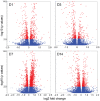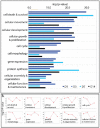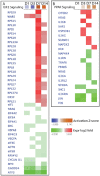Transcriptomic Impacts of Rumen Epithelium Induced by Butyrate Infusion in Dairy Cattle in Dry Period
- PMID: 29785087
- PMCID: PMC5954180
- DOI: 10.1177/1177625018774798
Transcriptomic Impacts of Rumen Epithelium Induced by Butyrate Infusion in Dairy Cattle in Dry Period
Abstract
The purpose of this study was to evaluate the effects of butyrate infusion on rumen epithelial transcriptome. Next-generation sequencing (NGS) and bioinformatics are used to accelerate our understanding of regulation in rumen epithelial transcriptome of cattle in the dry period induced by butyrate infusion at the level of the whole transcriptome. Butyrate, as an essential element of nutrients, is a histone deacetylase (HDAC) inhibitor that can alter histone acetylation and methylation, and plays a prominent role in regulating genomic activities influencing rumen nutrition utilization and function. Ruminal infusion of butyrate was following 0-hour sampling (baseline controls) and continued for 168 hours at a rate of 5.0 L/day of a 2.5 M solution as a continuous infusion. Following the 168-hour infusion, the infusion was stopped, and cows were maintained on the basal lactation ration for an additional 168 hours for sampling. Rumen epithelial samples were serially collected via biopsy through rumen fistulae at 0-, 24-, 72-, and 168-hour (D1, D3, D7) and 168-hour post-infusion (D14). In comparison with pre-infusion at 0 hours, a total of 3513 genes were identified to be impacted in the rumen epithelium by butyrate infusion at least once at different sampling time points at a stringent cutoff of false discovery rate (FDR) < 0.01. The maximal effect of butyrate was observed at day 7. Among these impacted genes, 117 genes were responsive consistently from day 1 to day 14, and another 42 genes were lasting through day 7. Temporal effects induced by butyrate infusion indicate that the transcriptomic alterations are very dynamic. Gene ontology (GO) enrichment analysis revealed that in the early stage of rumen butyrate infusion (on day 1 and day 3 of butyrate infusion), the transcriptomic effects in the rumen epithelium were involved with mitotic cell cycle process, cell cycle process, and regulation of cell cycle. Bioinformatic analysis of cellular functions, canonical pathways, and upstream regulator of impacted genes underlie the potential mechanisms of butyrate-induced gene expression regulation in rumen epithelium. The introduction of transcriptomic and bioinformatic technologies to study nutrigenomics in the farm animal presented a new prospect to study multiple levels of biological information to better apprehend the whole animal response to nutrition, physiological state, and their interactions. The nutrigenomics approach may eventually lead to more precise management of utilization of feed resources in a more effective approach.
Keywords: Butyrate; Dairy Cattle; epithelium; rumen; transcriptome.
Conflict of interest statement
Declaration of conflicting interests:The author(s) declared no potential conflicts of interest with respect to the research, authorship, and/or publication of this article.
Figures






Similar articles
-
Quantification of Transcriptome Responses of the Rumen Epithelium to Butyrate Infusion using RNA-seq Technology.Gene Regul Syst Bio. 2012;6:67-80. doi: 10.4137/GRSB.S9687. Epub 2012 May 16. Gene Regul Syst Bio. 2012. PMID: 22654504 Free PMC article.
-
Effects of dietary physical or nutritional factors on morphology of rumen papillae and transcriptome changes in lactating dairy cows based on three different forage-based diets.BMC Genomics. 2017 May 6;18(1):353. doi: 10.1186/s12864-017-3726-2. BMC Genomics. 2017. PMID: 28477620 Free PMC article.
-
Establishment and transcriptomic analyses of a cattle rumen epithelial primary cells (REPC) culture by bulk and single-cell RNA sequencing to elucidate interactions of butyrate and rumen development.Heliyon. 2020 Jun 9;6(6):e04112. doi: 10.1016/j.heliyon.2020.e04112. eCollection 2020 Jun. Heliyon. 2020. PMID: 32551379 Free PMC article.
-
Review: Exogenous butyrate: implications for the functional development of ruminal epithelium and calf performance.Animal. 2017 Sep;11(9):1522-1530. doi: 10.1017/S1751731117000167. Epub 2017 Feb 14. Animal. 2017. PMID: 28193308 Review.
-
Development and physiology of the rumen and the lower gut: Targets for improving gut health.J Dairy Sci. 2016 Jun;99(6):4955-4966. doi: 10.3168/jds.2015-10351. Epub 2016 Mar 9. J Dairy Sci. 2016. PMID: 26971143 Review.
Cited by
-
Transcriptional Reprogramming in Rumen Epithelium during the Developmental Transition of Pre-Ruminant to the Ruminant in Cattle.Animals (Basel). 2021 Sep 30;11(10):2870. doi: 10.3390/ani11102870. Animals (Basel). 2021. PMID: 34679891 Free PMC article.
-
Genome-Wide Acetylation Modification of H3K27ac in Bovine Rumen Cell Following Butyrate Exposure.Biomolecules. 2023 Jul 16;13(7):1137. doi: 10.3390/biom13071137. Biomolecules. 2023. PMID: 37509173 Free PMC article.
-
Toward a Symbiotic Perspective on Public Health: Recognizing the Ambivalence of Microbes in the Anthropocene.Microorganisms. 2020 May 16;8(5):746. doi: 10.3390/microorganisms8050746. Microorganisms. 2020. PMID: 32429344 Free PMC article.
-
Functional annotation of the cattle genome through systematic discovery and characterization of chromatin states and butyrate-induced variations.BMC Biol. 2019 Aug 16;17(1):68. doi: 10.1186/s12915-019-0687-8. BMC Biol. 2019. PMID: 31419979 Free PMC article.
-
Butyrate Induces Modifications of the CTCF-Binding Landscape in Cattle Cells.Biomolecules. 2022 Aug 25;12(9):1177. doi: 10.3390/biom12091177. Biomolecules. 2022. PMID: 36139015 Free PMC article.
References
-
- Osorio JS, Vailati-Riboni M, Palladino A, Loor JJ. Application of nutrigenomics in small ruminants: lactation, growth, and beyond. Small Rumin Res. 2017;154:29–44.
-
- Goff JP, Horst RL. Physiological changes at parturition and their relationship to metabolic disorders. J Dairy Sci. 1997;80:1260–1268. - PubMed
-
- Duplessis M, Lapierre H, Ouattara B, et al. Whole-body propionate and glucose metabolism of multiparous dairy cows receiving folic acid and vitamin B12 supplements. J Dairy Sci. 2017;100:8578–8589. - PubMed
-
- Gálfi P, Neogrady S, Sakata T. Effects of volatile fatty acids on the epithelial cell proliferation of the digestive tract and its hormonal mediation. In: Tsuda T, ed. Proceedings of the Seventh International Symposium on Ruminant Physiology San Diego, CA: Academic Press; 1991:49–59.
-
- Bergman EN. Energy contributions of volatile fatty acids from the gastrointestinal tract in various species. Physiol Rev. 1990;70:567–590. - PubMed
LinkOut - more resources
Full Text Sources
Other Literature Sources

